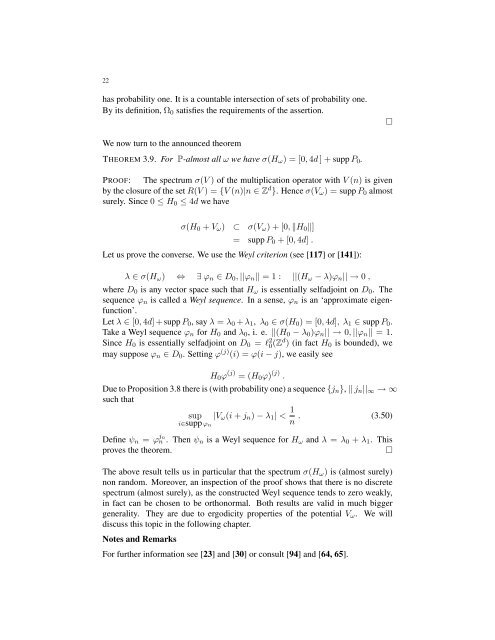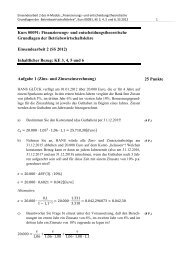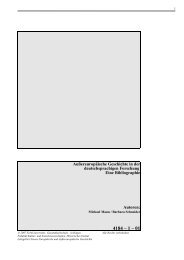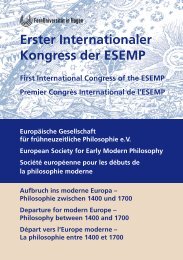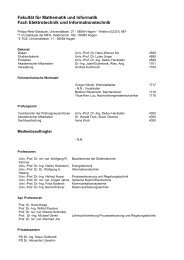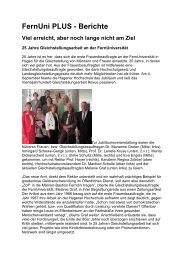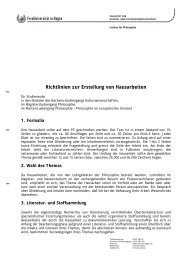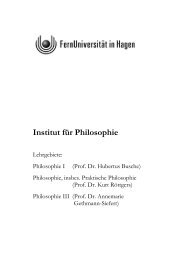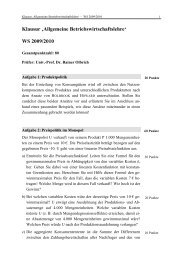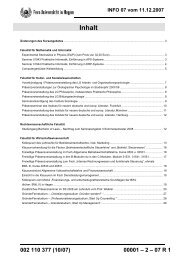An Invitation to Random Schr¨odinger operators - FernUniversität in ...
An Invitation to Random Schr¨odinger operators - FernUniversität in ...
An Invitation to Random Schr¨odinger operators - FernUniversität in ...
Create successful ePaper yourself
Turn your PDF publications into a flip-book with our unique Google optimized e-Paper software.
22<br />
has probability one. It is a countable <strong>in</strong>tersection of sets of probability one.<br />
By its def<strong>in</strong>ition, Ω 0 satisfies the requirements of the assertion.<br />
□<br />
We now turn <strong>to</strong> the announced theorem<br />
THEOREM 3.9. For P-almost all ω we have σ(H ω ) = [0, 4d ] + supp P 0 .<br />
PROOF: The spectrum σ(V ) of the multiplication opera<strong>to</strong>r with V (n) is given<br />
by the closure of the set R(V ) = {V (n)|n ∈ Z d }. Hence σ(V ω ) = supp P 0 almost<br />
surely. S<strong>in</strong>ce 0 ≤ H 0 ≤ 4d we have<br />
σ(H 0 + V ω ) ⊂ σ(V ω ) + [0, ‖H 0 ‖]<br />
= supp P 0 + [0, 4d] .<br />
Let us prove the converse. We use the Weyl criterion (see [117] or [141]):<br />
λ ∈ σ(H ω ) ⇔ ∃ ϕ n ∈ D 0 , ||ϕ n || = 1 : ||(H ω − λ)ϕ n || → 0 ,<br />
where D 0 is any vec<strong>to</strong>r space such that H ω is essentially selfadjo<strong>in</strong>t on D 0 . The<br />
sequence ϕ n is called a Weyl sequence. In a sense, ϕ n is an ‘approximate eigenfunction’.<br />
Let λ ∈ [0, 4d] + supp P 0 , say λ = λ 0 + λ 1 , λ 0 ∈ σ(H 0 ) = [0, 4d], λ 1 ∈ supp P 0 .<br />
Take a Weyl sequence ϕ n for H 0 and λ 0 , i. e. ||(H 0 − λ 0 )ϕ n || → 0, ||ϕ n || = 1.<br />
S<strong>in</strong>ce H 0 is essentially selfadjo<strong>in</strong>t on D 0 = l 2 0 (Zd ) (<strong>in</strong> fact H 0 is bounded), we<br />
may suppose ϕ n ∈ D 0 . Sett<strong>in</strong>g ϕ (j) (i) = ϕ(i − j), we easily see<br />
H 0 ϕ (j) = (H 0 ϕ) (j) .<br />
Due <strong>to</strong> Proposition 3.8 there is (with probability one) a sequence {j n }, || j n || ∞ → ∞<br />
such that<br />
sup<br />
i∈supp ϕ n<br />
|V ω (i + j n ) − λ 1 | < 1 n . (3.50)<br />
Def<strong>in</strong>e ψ n = ϕ jn<br />
n . Then ψ n is a Weyl sequence for H ω and λ = λ 0 + λ 1 . This<br />
proves the theorem.<br />
□<br />
The above result tells us <strong>in</strong> particular that the spectrum σ(H ω ) is (almost surely)<br />
non random. Moreover, an <strong>in</strong>spection of the proof shows that there is no discrete<br />
spectrum (almost surely), as the constructed Weyl sequence tends <strong>to</strong> zero weakly,<br />
<strong>in</strong> fact can be chosen <strong>to</strong> be orthonormal. Both results are valid <strong>in</strong> much bigger<br />
generality. They are due <strong>to</strong> ergodicity properties of the potential V ω . We will<br />
discuss this <strong>to</strong>pic <strong>in</strong> the follow<strong>in</strong>g chapter.<br />
Notes and Remarks<br />
For further <strong>in</strong>formation see [23] and [30] or consult [94] and [64, 65].


